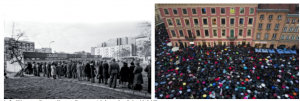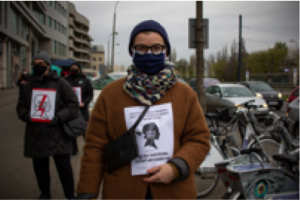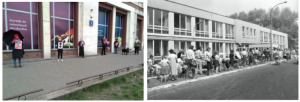Public protest in the age of Covid-19 (Journal of Visual Culture & HaFI, 10)
This is the tenth instalment of a collaborative effort by the Journal of Visual Culture and the Harun Farocki Institut, initiated by the COVID-19 crisis. The call sent to JVC’s editorial board, and a wide selection of previous contributors and members of its extended communities, described the task as follows: “There is a lot of spontaneous, ad hoc opinion-making and premature commentary around, as to be expected. However, the ethics and politics of artistic and theoretical practice to be pursued in this situation should oblige us to stay cautious and to intervene with care in the discussion. As one of JVC’s editors, Brooke Belisle, explains: ‘We are not looking for sensationalism, but rather, moments of reflection that: make connections between what’s happening now and the larger intellectual contexts that our readership shares; offer small ways to be reflective and to draw on tools we have and things we know instead of just feeling numb and overwhelmed; help serve as intellectual community for one another while we are isolated; support the work of being thoughtful and trying to find/make meaning…which is always a collective endeavour, even if we are forced to be apart.'” TH
Public protest in the Age of Covid19
Was April the cruelest of the months of lockdown?
I see my dry hands, clean as hell, as never before. And I see fear in a handful of sanitizer.
First, we got socially immobilized, publicly absent, forcefully attached to our households. In Poland, leaving one’s home was only legal if one was heading to work or to satisfy the necessities of everyday life.
A crisis like this one hits the weakest and it seems at its core it means ‘a disaster to feminism’. Five weeks into the crisis Polish parliament decided to proceed a citizens’ bill to make even more stringent what has already been one of the most restrictive abortion laws in Europe. Ironically, while coronavirus seems to affect women less severely, the alt-right will try to re-claim its share.

left: Warsaw-Praga, line to Pewex, Aleksander Jałosiński/Forum
right: Warsaw, 3.10.2016, Black Monday, Chris Niedenthal (Archiwum Prostestów Publicznych)
The first thesis of the recently published manifesto, Feminism for the 99%, bespeaks the reinvention of the strike which took place in October 2016 in Poland, ‘when more than 100,000 women staged walkouts and marches to oppose the country’s ban on abortion.’[1] Yet it was not even 4 years later, when women under lockdown had to reinvent the strike again.
How to protest in the times of coronavirus, how not to surrender at the times of utmost confusion and fragility?
Amidst the health care crisis, we had to manifest exceptional self-care and solidarity without being able to take to the streets.
In this state of exception, measures were taken spontaneously and collectively, and beside online campaigning, we did go out, nevertheless. People began to form lines – keeping the prescribed distance – in front of grocery stores, waiting to satisfy their basic needs. This has been powerfully and ironically resonant of queuing in socialist times: hopeless and frequently fruitless everyday practice which was not teaching people – as some wish to believe – solidarity as much as it was exercising their despair and humiliation, especially in the 1980s, the first decade of my life.
left: Warsaw, 15.04.2020, Agata Siwiak
right: East News, Karol Malcuzynski
The queue I remember best, however, was an exceptional one on a spring day in 1986 when among a mass of people, we waited the get lifesaving Lugol’s iodine supposedly a protection against radioactivity flowing from Chernobyl. Another invisible threat, a concealed killer.
Is April the cruelest month mixing memory and militancy?

Warsaw, 15.04.2020, Jasza Strongin
